MARKET OVERVIEW
The Global Textile Dyeing & Sustainability market and the industry engaged are quite considerable in shaping the future of eco-sensitive fabric production. Higher demand for textiles is observed in fashion, home furnishing, and industrial applications, and dyeing has been one area of consideration that has impacted the environment. The industry is in transformation under the urgency to minimize water consumption and chemical waste and use sustainable alternatives in consonance with regulations and consumer preference.
Textile dyeing is one of the most resource-demanding processes in fabric production, using plenty of water and chemicals. With growing scrutiny over wastewater discharge and carbon emissions, manufacturers are looking for new methods to reduce the negative impact of fabric dyeing on the environment. The market symbolizes an ongoing dynamic shift toward organic dyes and waterless dyeing technology and digital printing techniques that cut foul play to the minimum. Sustainability is no longer a choice: brands and manufacturers must work within the framework of strict international regulations and corporate sustainability goals.
Technologies will keep changing the future of the market. Industries are moving away from conventional wet-processing techniques, putting water-free methods such as supercritical CO2 dyeing and plasma treatments into the limelight. Alternatively, bio-based dyes from natural sources, including plants, algae, and bacteria, could become an alternative to synthetic counterparts, thus curbing dependence on petrochemical-based products. Supply chain transparency would thus be enhanced with facilities available for brands to track the sustainability credentials of these dyeing processes through blockchain and artificial monitoring systems.
Meanwhile, the market will continue to evolve in response to regional dynamics, with Asia-Pacific taking a lead because of its mammoth textile manufacturing base. In contrast, the European and North American geographies will force-clean technologies and circular economy practices with rather stringent environmental policies. Closed-loop systems, water recycling, and dye recovery shall receive massive investments from manufacturers in these regions to reverse the adverse effect on local ecosystems. Moreover, the transition toward decentralized production models will increase awareness about reduction in transportation emissions and local compliance with environmental regulations.
Consumer awareness will propel the changing face of the market. With sustainability concerns being at the forefront, textile and fashion brands will increasingly feel the pressure to divulge and disclose their dyeing practices. Certification systems such as OEKO-TEX, GOTS, and Bluesign will become common indicators of sustainable textiles, thus pressurizing manufacturers to adopt cleaner production methods. Suppliers must prepare for an increase in demand for dyes that are derived from plants and are non-toxic, fast-fading, and biodegradable, creating push factors for suppliers to formulate and innovate their product range.
Legislators are likely to rule the state of the market in the future. Governments around the world will certainly tighten rules on effluent discharge, microplastic pollution, and chemical use in textiles. These laws will require further investment in developing better wastewater treatment plants and ultimately, non-toxic dye formulations. With sustainable practices already established as a competitive advantage, any company that puts off change could face regulatory penalties and a backlash from consumers.
The Global Textile Dyeing & Sustainability market will receive continuous improvements as far as environmental issues are thrown in the forefront. Innovation, regulatory compliance, and consumer-driven sustainability will urge the industry toward more eco-friendly solutions. While applying environmental measures in their production processes, the stakeholders would promote new trends in the market for sustainable environmental accountability, setting the future in which sustainability and efficiency would go hand in hand.
Global Textile Dyeing & Sustainability market is estimated to reach $22,170.77 Million by 2032; growing at a CAGR of 6.3% from 2025 to 2032.
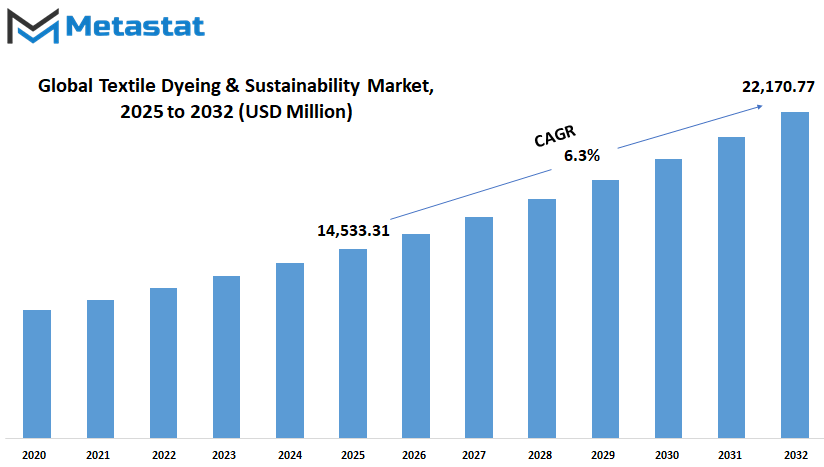
GROWTH FACTORS
Manufacturers and consumers are putting sustainability at the forefront of the transformation that is sweeping across the textile industry. With increasing awareness about the adverse environmental effects of traditional dyeing processes, such demand in the Global Textile Dyeing & Sustainability market pushes end users for greener solutions. More and more organic and sustainable textiles are being adopted by consumers knowing that their choices have an impact- and that is influencing manufacturers to put eco-friendly practices into place, thus creating a more potent impetus for innovation in dyeing techniques.
The role of government regulations is also crucial in shaping the market. Many are now imposing strict environmental policies to reduce water pollution and wastage of chemicals. This often leads businesses to spend on sustainable dyeing processes that are less harmful to the environment. Though meant to add value to the industry, such policies sometimes pose challenges to companies that have to upgrade their methods to meet new standards. On the other hand, some find it financially difficult to implement sustainable means, hence slow progress.
One such big problem that manufacturers have in the Global Textile Dyeing & Sustainability market is the high investment cost for adopting eco-friendly technologies. A lot of new sustainable dyeing methods involve very sophisticated equipment as well as specialized materials to carry out the process, which makes it quite expensive for many manufacturers to implement.the natural and non-toxic dyes still remain available on the market. Although a lot of research is in the process of better alternative development, none of the currently available options have yet proved to be as efficient or cost effective as synthetic dyes. This makes a compromise for businesses that cannot devote an entire budget to following sustainable practices without incurring additional production costs.
All these challenges notwithstanding, advancements in current technology pave the way for new opportunities within the industry. Waterless dyeing techniques and further developments in digital dyeing are now emerging as the most promising and successful solutions for reducing ecological footprints concerning the manufacturing process. Less water and energy use is characteristic of these technologies as applied to the manufacturing of textiles again from yarn or fabric and thus is much more sustainable, compared to previous methods. Therefore, as research is continuing to improve these methods, it is expected to gain much greater acceptance and alteration of the actual production processes in the production of textiles in the future.
The Global Textile Dyeing & Sustainability market, for that matter, would continue to grow steadily into the future with the emphasis on sustainability in the fashion and textile industries. Consumer taste will push the demand for eco-friendly products, and for that reason, manufacturers will be in a position to find better ways to reduce waste and pollution from their activities. Furthermore, technological innovations making sustainable dyeing processes efficient will pave the way for environmental responsibility and innovation within the industry. Although challenges remain, the progress being made suggests a positive outlook for the market in the years to come.
MARKET SEGMENTATION
By Type
Recent developments in dyeing technology and increasing emphasis on reducing environmental impact are expected to cause a boom in the global textile dyeing and sustainability market. Soon, manufacturers may pour in enormous investment for research and development towards forming both effective and eco-friendly dyes.
Various types of dyes are available in the market now. Each has unique properties and specific uses. Direct dyes are used mainly on cellulose fibers and are characterized by being very simple and easy to apply. The dyes called reactive exhibit a very strong bond with the fiber, resulting in bright and lasting colors. VAT dyes’ most remarkable attribute is outstanding colorfastness, and that is why they are predominantly used on cotton fabrics. Basic dyes on acrylic fibers and acid dyes on wool and silk are thus termed. Disperse dyes are primarily used for synthetic fibres like polyester.
The industry will increasingly focus on the development of sustainability dyes that cut down water consumption and discharge toxic chemicals. Infrastructure development may include making biodegradable dyes and adopting closed-loop systems that can recycle water and other resources. Agricultural dyes could also receive renewed interest, along with large mandates for plant and renewable-based alternative dyes that would be more sustainable than synthetic.
This change will require the unification of supply chains. Brands, suppliers, and consumers will pool efforts in promoting the practice of sustainability and environmental dye adoption. Traceability on sourcing and production processes will gain importance, allowing consumers to make educated decisions.
In conclusion, there should be a great thrust in the global textile dyeing and sustainability market. The industry will need to apply innovative dyeing methods with environmental concerns on its way to fulfilling the new chord of sustainable textiles. This forward movement is part of the concept of responsible production and consumption, which translates the way towards a sustainable future for fashion and textiles.
By Fibre Type
In the textile dyeing world, major transitions are happening with sustainability becoming a goal. This comes from awareness of environmental impacts with the respective needs for eco-friendly production. Traditional dyeing methods or procedures are often linked with the use of harmful chemicals as well as excessive water consumption that results in pollution and depletion of resources. The major change that is going on in global textile dyeing and sustainability is responding to such challenges.
Perfectly in line with that, sustainable dyeing techniques are being developed. For instance, methods such as waterless dyeing or even the employment of natural dyes are developing. These holler about less water consumption where the procedure is more natural. On the other hand, natural dyes provide biodegradable options to synthetic kinds. These innovations strategize environmental footprint reduction while ensuing responsible production.
Market prospects are also planning ways on dyeing a certain fiber. Different fibers- wool, nylon, cotton, viscose, polyester, and acrylic-all require different methods for their dyeing. A good illustration is through the most popular fiber-exciting absorbent cotton-gaining the most from those dyes that bond well but soak extensively. Besides, synthetic polyester polyfiber often needs disperse dyes at high temperatures. Specialized products and processes for each kind of fiber will set new benchmarks in efficiency and sustainability for the industry.
Another driving force in this transformation is consumer demand, with shoppers now more inclined towards things that are eco-friendly. This has forced brands to innovate beyond their average sustainable methods to trail behind the trend of having transparent supply chains and certifications that reflect minimal harm to the environment during textile production. This trend driven by consumers will eventually lead to spending on such green technologies as well as sustainable materials.
The technological integration will thus set pace in the progressive evolution of the market. Digital dyeing technologies apply a precise color use that minimizes wastage and improves the standardization of dyes. Future biotechnological advances may open avenues for developing new sustainable compounds from dye created by such methods, and the most unbelievable and possible revolution of the industry will be shortened efficient, and friendly alternatives.
Sustainable practices across the supply chain should be implemented meaningfully by bringing manufacturers, suppliers, and retailers together. These range from cleaner production to waste minimization and include ethical labor practices. By creating a culture of sustainability, the textile dyeing industry will adopt a healthy and responsible direction for the coming days.
The change in the landscape of this market will be mainly fueled by the above factors. Emerging techniques, solutions that target a specific fiber, consumer engagement, technology, and integration-all of these changes will be engrossed by this industry’s performance in addressing environmental concerns and laying a strong foundation for the future of sustainable practice.
By Application
The Trends in the Global Textile Dyeing & Sustainability market are slowly but steadily shifting toward being ecologically inclined and efficient as the industry realizes the need for sustainable production. Long associated with severe water consumption, pollution, and discharge of toxic chemicals, the textile industry is now! As awareness grows and environmental regulations tighten, these companies focus significantly more on cleaner alternatives. Moreover, innovative technology in dyeing promises to even influence this important industry; it is paving the way toward a more accountable and efficient approach.
One aspect of changing the course of the future for textile dyeing is the use of new advanced methods minimizing impact on the environment. Conventional dyeing practices have been very dependent on consuming much water that contaminates natural water bodies. With a strong push to go sustainability, newer technology development comes in to minimize water usage and chemical wastage. Waterless dyeing techniques, for instance, are increasingly popular and promise a solution: using less resource and keeping the fabric bright and good quality. Another new process that uses less chemical during dyeing and generates less waste is digital printing.
The Global Textile Dyeing & Sustainability market is emerging with its applications like exhaust dyeing, continuous dyeing, and semi-continuous dyeing. All of them have their specific and dedicated use in any process to be adopted as per different fabrics and scales of production. Exhaust dyeing, in which textiles completely soak in a dye bath, has fructified a great deal and now needs improvement by using environmentally safe dye formulations.
Continuous dyeing is being accepted since it provides highly effective productivity in addition to reduction in water consumption; per example, this process allows fabrics to pass through a dyeing system without any interruption. Semi-continuous dyeing incorporates some features of both batch and continuous methods and provides markets with flexibility without a major impact on the environment. At some extent, all techniques are refined and aligned in the same direction for sustainability objectives; for which, manufacturers are experimenting with bio-based dyes and recycled products.
Both consumers and regulation are driving demand for sustainability in textile dyeing. Consumers are becoming increasingly aware of how these choices harm the environment. Rules and regulations are becoming more stringent and are leading companies toward the practice of using low-impact dyes and energy-saving processes. The future of Global Textile Dyeing & Sustainability Market might hold even more breakthroughs with biotechnology and artificial intelligence leading the way in formulating and applying dyes.
The manufacturers and brands will involve policymakers in the collaboration as the sector moves forward to attain sustainability in the long term within the industry. The focus will be on waste reduction, energy efficiency improvement, and alternatives to synthetic dyeing with bright color due to their harmful effect on the environment. Textile dyeing goes more sustainable with innovation and commitment by opening a way for the future toward a greener world of environmental responsibility in fashion.
By End Users
Market for Global Dyeing and Sustainability in the Textile Industry. The global marketplace for textile dyeing blended with sustainability has been changing relatively quickly due to growing environmental triggers or push factors, for example, diverse needs for more eco-friendly technologies. Such sites where industries have found out the impact of conventional dyeing methods over the environment worldwide are now shifting towards a sustainable alternative. These patterns are majorly observable among multi-sectors, including clothing and apparel, home textiles, as well as industrial textiles.
Shopping for clothes and accessories, consumers are now environmental-conscious. In accordance with such principles, brands would be stepping on new innovations for sustainable dyeing methods, which minimize water consumption as well as the emission of harmful chemicals. Advancements such as those in natural dyes from plants to biodegradable products evoke bright colors without significantly affecting ecology. Also, along with most recent advancements in technology, there are efficient processes of dyeing further to the reduction of environmental impacts.
Home textiles-tea which counts bedding, curtains, upholstery and so on also now moves towards sustainability; manufacturers are looking up into green dyeing methods commonly known by consumer demands towards green products. These kinds of methods usually involve using low-impact dyes and closed-loop systems, which recycle water and reduce waste. Hence, through bringing the theme of sustainability, not just because of the environment, but it is plausible to target the market segment that considers how products are made.
Moreover, the industrial textile source of plenty of applied materials for automotive applications, medical-samples, or construction-purpose items are gradually recognizing the need for sustainable dyeing solutions. Because of that reason, production in this sector is carried at a large scale consumption; this enables the environment to reap great benefits through the adoption of environmentally friendly dyeing processes. Innovations such as digital printing technologies are increasingly ascertained for dye and water consumption reduction, making the industrial sector meet its targets in the world with sustainability.
It is with great expectation that the evolution of the market for global textile dyeing continues in its innovative line. The multipronged collaborative efforts of researchers, manufacturers, and politicians will ever take even clear terms to formulate and implement practices achieving simultaneous aesthetic with environmental responsibility. Artificial intelligence and machine learning shall potentially work in this field as it progresses in technology in optimizing dyeing processes, reducing resource usage and waste.
In light of the above, it encompasses movement to sustainable dyeing practices within all sectors of the clothing and apparel industry, home textiles, and industrial textiles. This thus becomes a much bigger commitment to environmental stewardship in its own right. By embracing innovative solutions with an eye for sustainability, so does the global textile dyeing industry pave the way for a more responsible, environmentally conscious future.
|
Forecast Period |
2025-2032 |
|
Market Size in 2025 |
$14,533.31 million |
|
Market Size by 2032 |
$22,170.77 Million |
|
Growth Rate from 2025 to 2032 |
6.3% |
|
Base Year |
2024 |
|
Regions Covered |
North America, Europe, Asia-Pacific, South America, Middle East & Africa |
REGIONAL ANALYSIS
The textile dyeing industry is rapidly and dramatically changing with regard to consultants on sustainability. Every country practices cleaner technology and green approaches to minimizing pollution and conserving natural resources. This would cause distinct activities by different regions and countries that would apply the alterations on their own based on their respective economic states, government regulations, and advanced technological developments.
The North Americans are striding under the umbrella of sustainability into textile dyeing, with increasing environmental consciousness from stirring regulations. USA and Canada now currently lead in employing waterless dyeing methods along with biodegradable dyes, which decrease the impacts of chemical waste on ecosystems. As rapidly booming Mexico's textile industry develops, it has begun shifting to greener options, driven by consumers and pressures of global big brands. These companies spend on research investigating innovative answers to minimize water and energy consumption.
Europe is setting a precedent in sustainable textile dyeing, with the likes of the UK, Germany, and France defining strict environmental standards. The stringent regulations propel manufacturers into the adoption of organic dyes and closed-loop water courses that protect against contamination. Italy, home of fashion, is witnessing luxury brands adopting more eco-friendly dyeing techniques to satisfy the consumer's burgeoning demand for sustainable clothing. The situation is fast changing with the increasing number of consumers gradually shifting from environmentally hazardous products to those they find to be responsible in terms of the environment, thus prioritizing businesses in this region towards such efforts.
Asia-Pacific remains an important landscape for textile manufacturing where China, India, and Bangladesh are the main players. Although the conventional method of dyeing is still dominating, the trend is rapidly moving towards the adoption of sustainable techniques. Governments are implementing policies around waste water disposal for sectors under which plants are experimenting with plant-based dyes and digital printing to minimize waste. Japan and South Korea, to name a few, combine their scientific and technological innovations in a consistent effort to achieve advanced means of doing things such as water-free dyeing and waste recycling systems. With awareness increasing and stricter demands levied by international brands for much greener supply chains, this region is expected to add to the weave of the future of sustainable textile dyeing.
Slowly, South America is adopting the concept of sustainability in textile production. Brazil, popularly known for textile production, induces actions that really minimize dye processes from causing negative environmental impacts. Argentina and the rest of the region are trying to fall in line with this new perspective by minimizing improvements in wastewater treatment and advocating for natural dye alternatives. Challenges certainly exist, but growing awareness and investments in cleaner technologies will certainly clear the way toward a sustainable future.
Sustainable textile dyeing conversion in Middle East & Africa will also depend on resource endowment and legislative frameworks. The GCC countries are exploring dry dyeing and other innovative techniques to minimize water requirements, given the scarcity of water resources in the region. South Africa also recorded an increase in effort regarding eco-friendly textile production, thanks to the input of both the local and international markets. This region is poised to contribute significantly to the global trend toward socially responsible textile dyeing with the improvement of infrastructures and investments into sustainable practices.
Looking forward, it seems that the uptake of sustainable textile dyeing will keep increasing because of tightening regulations and shifting consumer expectation trends. Innovations in dyeing technology and further collaborative endeavors between industries and governments will contribute significantly towards bringing into shape the more environmental future of the textile industry.

COMPETITIVE PLAYERS
The transformation that marks perhaps the most defining nature of the textile dyeing industry is the incorporation of sustainability for companies all over the world. Apart from the rising environmental concerns, consumers are now also demanding eco-friendly products. Hence, organizations are moving towards adopting sustainable practices for the lessening of their ecological footprints and satisfying the expectations of the more environmentally conscious market.
Firms such as Archroma, Huntsman International LLC, Inditex (Zara), Vivify Textiles, DyStar Singapore Pte Ltd, Atul Ltd, Ahmad Jamal Textile Mills, Metro Dyeing LLC, Milliken & Company, Sudeep Industries, and several others are the leading names in initiating the change in the textile dyeing domain. These companies are invested in the research and development of novel dyeing methods to minimize water consumption and energy utilization while bringing about less discharge of harmful chemicals into the environment.
In lieu of synthetic dyes, some firms are also investigating whether plant-based natural dyes and other renewable alternatives could be an option. This approach would work comparatively toward a lower environmental burden and toward winning over consumers who want natural and organic products. Advances in dyeing technology, such as digital printing and supercritical CO₂ dyeing, present just a faster and greener alternative as opposed to conventional ones along with these natural dye alternatives.
Yet another driver of sustainability is cooperation among the industries. Through partnerships, companies are sharing knowledge on standardized practices and sustainable supply chain management. A project implemented by the stakeholders is geared toward fostering a transparent and responsible nature of the textile-dyeing industry.
The other side of the coin is that sustainability will be a growing trend with stricter environmental regulations and an expanding consumer base that demands green products. Organizations that are fast on the road to sustainable practices will obviously comply with the laid-out regulations and gain a competitive upper hand over other companies. Surely, this early-bird approach could harness brand loyalty and opportunities as these companies explore the path of sustainable differentiation.
Thus, the global textile dyeing industry is currently facing a paradigm shift towards sustainability, mainly motivated by environmental issues and consumer preferences. The leading companies have set their mark into the movement of adopting the ever-changing eco-friendliness into their innovative ways. Thus, sustainability will remain the crux of any evolution that is still shaping the business model and basically delineating the future for textile dyeing.
Textile Dyeing & Sustainability Market Key Segments:
By Type
- Direct Dyes
- Reactive Dyes
- VAT Dyes
- Basic Dyes
- Acid Dyes
- Disperse Dyes
By Fibre Type
- Wool
- Nylon
- Cotton
- Viscose
- Polyester
- Acrylic
By Application
- Exhaust Dyeing
- Continuous Dyeing
- Semi-Continuous Dyeing
By End Users
- Clothing & Apparel Industry
- Home Textiles
- Industrial Textiles
Key Global Textile Dyeing & Sustainability Industry Players
- Archroma
- Huntsman International LLC
- Inditex (Zara)
- Vivify Textiles
- DyStar Singapore Pte Ltd
- Atul Ltd
- Ahmad Jamal Textile Mills
- Metro Dyeing LLC
- Milliken & Company
- Sudeep Industries
WHAT REPORT PROVIDES
- Full in-depth analysis of the parent Industry
- Important changes in market and its dynamics
- Segmentation details of the market
- Former, on-going, and projected market analysis in terms of volume and value
- Assessment of niche industry developments
- Market share analysis
- Key strategies of major players
- Emerging segments and regional growth potential



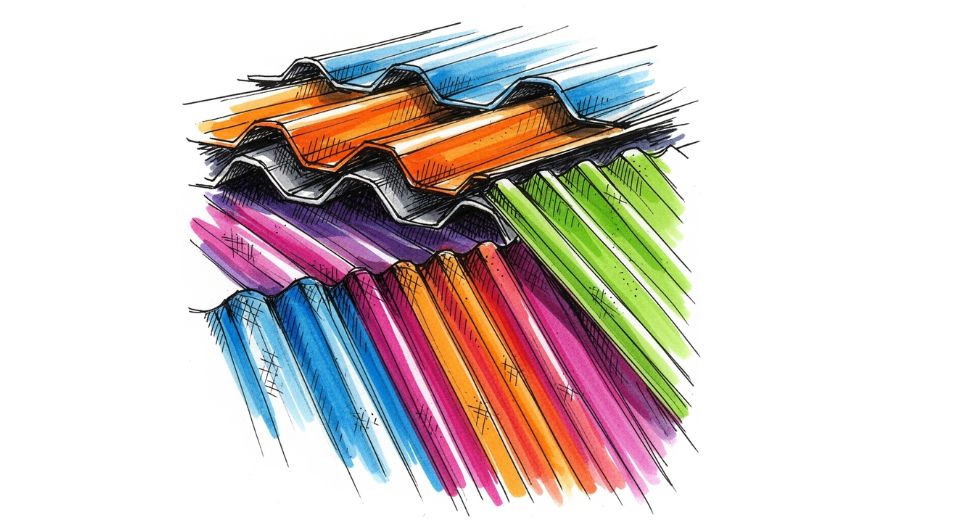
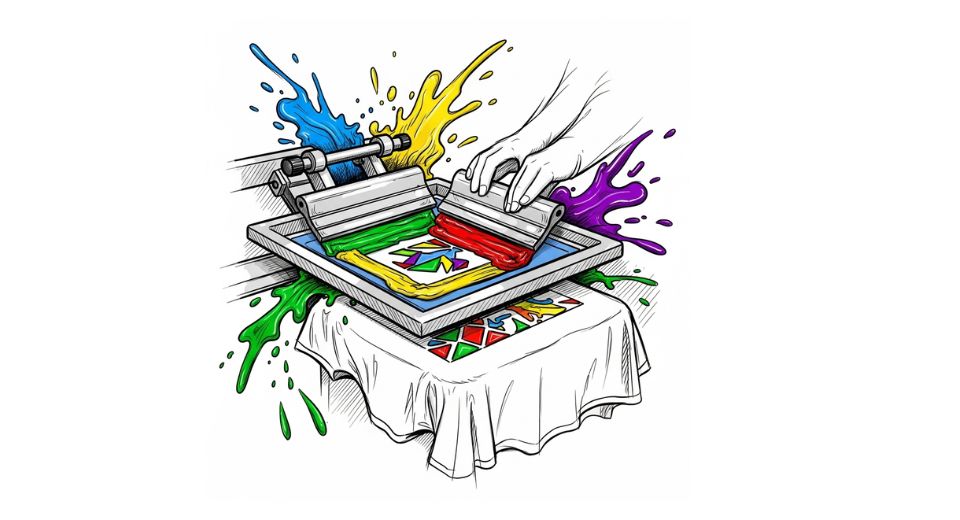
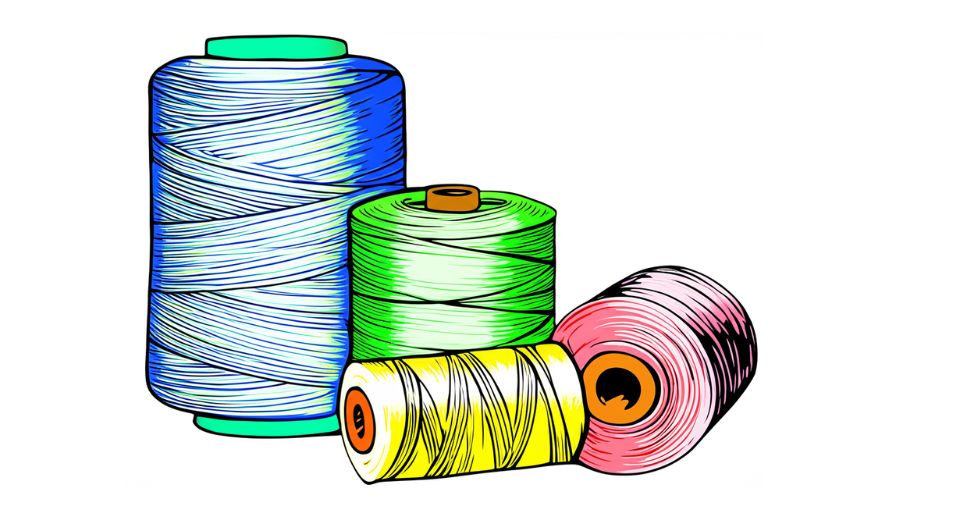
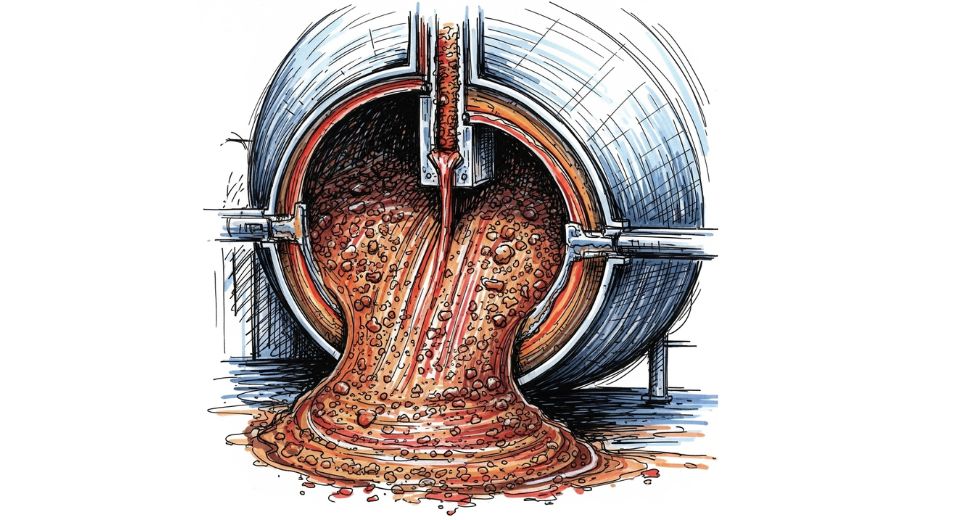

 US: +1 3023308252
US: +1 3023308252






